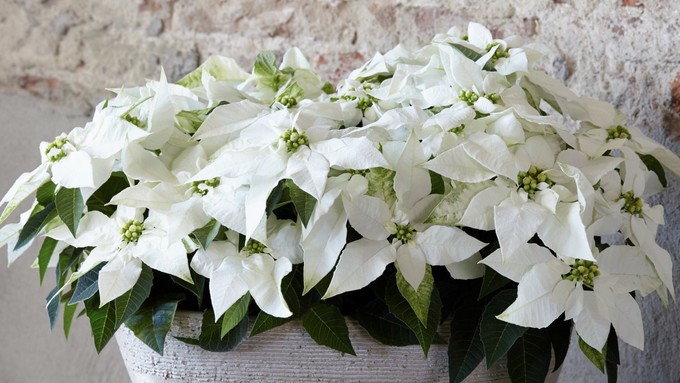
Tips for selecting healthy holiday plants

Poinsettias these days come in many more colors than the classic red, including white, yellow, gold, pink and variegated. Photo courtesy National Garden Bureau
It’s poinsettia season and this Mexican native is everywhere, forced into December bloom. The poinsettias available today are better than the ones sold a generation ago – and it’s not just the wider range of colors.
“Breeders are also enhancing features that make the plants more enjoyable for everyone,” says Diane Blazek, executive director of National Garden Bureau. “They’re developing varieties that bloom earlier, have longer-lasting blooms, and unique bract shapes.”
The bracts – what most people think of as petals – now come curly, skinny or extra wide. No matter the bract shape, the key to selecting a fresh poinsettia that will last until New Year’s is focusing on what’s at that center of those bracts – the small yellow true flowers or cyathia. They should look fresh and not turning brown. Any poinsettias missing those little yellow flowers are past their prime.
The bracts should appear fresh, too, but also notice the dark green leaves lower on the stem. Make sure the foliage looks healthy and not drooping or falling off.
According to experts, the most common problem with poinsettias is overwatering. People kill them with kindness. Take off the foil wrapper or punch holes in the bottom (and place a saucer underneath). Poinsettias – semi-tropical members of the Euphorbia family – demand good drainage and prefer soil on the dry side of moist. Give the plant a drink once a week (or as needed) and don’t let the poinsettia stand in water. The best way to know if your poinsettia needs watering? Pick it up. If it seems light, it’s time to water.
Cold kills poinsettias; they can’t take prolonged temperatures under 50 degrees. So, if decorating with poinsettias outdoors, bring them inside or protect them at night. They prefer bright light and temperatures between 65 and 70 degrees (just like most people do).
Contrary to popular belief, poinsettias are not poisonous – to people, dogs or cats. Studies at Ohio State and Washington State universities debunked myths about poinsettia toxicity. A 50-pound child would need to eat more than 500 poinsettia bracts to reach a toxic level.
That doesn’t mean poinsettias are edible. Their milky sap will cause mouth and skin irritation (and keep any person or animal from munching them).
For more on poinsettia care: https://ucanr.edu/sites/urbanhort/files/80155.pdf
Comments
0 comments have been posted.Sacramento Digs Gardening to your inbox.
Sites We Like
Garden Checklist for week of July 21
Your garden needs you!
* Keep your vegetable garden watered, mulched and weeded. Water before 8 a.m. to reduce the chance of fungal infection and to conserve moisture.
* Feed vegetable plants bone meal, rock phosphate or other fertilizers high in phosphate to stimulate more blooms and fruiting. (But wait until daily high temperatures drop out of the 100s.)
* Don’t let tomatoes wilt or dry out completely. Give tomatoes a deep watering two to three times a week.
* Harvest vegetables promptly to encourage plants to produce more. Squash especially tends to grow rapidly in hot weather. Keep an eye on zucchini.
* Pinch back chrysanthemums for bushy plants and more flowers in September.
* Remove spent flowers from roses, daylilies and other bloomers as they finish flowering.
* Pinch off blooms from basil so the plant will grow more leaves.
* Cut back lavender after flowering to promote a second bloom.
* It's not too late to add a splash of color. Plant petunias, snapdragons, zinnias and marigolds.
* From seed, plant corn, pumpkins, radishes, winter squash and sunflowers.